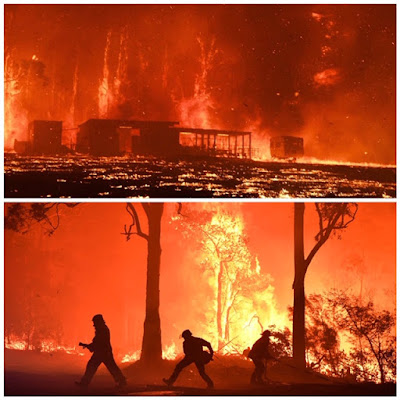They published the story below which says it all about the recent tragic events in Australia better than I ever could.
 It has been a summer lost forever.
It has been a summer lost forever. A summer in which the traditions we cherish, of beach holidays, of camping trips, of watching fireworks on a grassy hill, have been stolen by the terrifying forces of nature.
Drought, hail, floods and, worst of all, fire have ravaged all parts of the nation.
Homes have been razed, lives lost, millions of hectares of bushland burnt and unimaginable numbers of wildlife have perished. Businesses have shut down starved of their summer trade. Smoke has choked cities. Waves of dust have enveloped whole towns.
It has been the summer that has tested us in ways that have defied experience, if not prediction.
The world has looked on with grave concern and responded with generosity. Tears have been shed on our behalf by people who have never been on our shores.
We have seen the best of our human qualities on display. In every village, town and city, every day. But through this extraordinary and this terrible time, it has been our strong community bonds that have helped us into the aftermath.
Volunteerism, that spirit of giving that is a pride of Australian life, has rarely looked more
magnificent than in the brigades of firefighters putting themselves between life and property and the monstrous approaching fire fronts. Their bravery and dedication has moved us all.
In the aftermath of the summer's fast-hitting disasters, or through the enduring grip of drought, we have seen the best of our human qualities on display. In every village, town and city, every day.
Neighbours opening their homes to a displaced neighbour. Community groups of all types setting up kitchens to feed evacuees. People rushing to help rebuild burnt fences. Vets with the unspeakably sad task of euthanizing injured stock and wildlife.
 Fridges stocked with cold drinks for passing emergency crews. Wildlife carers converting their homes to animal sanctuaries. Truck drivers bringing load after load of stock feed or urgent supplies to drought-stricken or smouldering villages and farms.
Fridges stocked with cold drinks for passing emergency crews. Wildlife carers converting their homes to animal sanctuaries. Truck drivers bringing load after load of stock feed or urgent supplies to drought-stricken or smouldering villages and farms.Some people owe their lives to a stranger, whether that stranger was wearing a uniform or the summer dress of a holidaymaker. Selfless action in moments of utter terror.
For all of these kinds of stories that have already been told, there are countless more that deserve to be heard. And so at Australian Community Media we want to give voice to them and give thanks to the heroes of the home front.
Stories of efforts that have helped your community in its darkest times. Of the smallest acts of kindness and generosity that have reminded you how good people really are.
Acts motivated by love for community and care for one another.
Please join us in sharing your stories of gratitude. It doesn't matter how, it doesn't matter where.
We will publish as many responses as we can online and in special print editions in coming weeks.
We were treated with empathy and kindness by friends, neighbours, acquaintances, government workers and complete strangers during our week of evacuation and those that followed. The entire community came together during a time of crises which somewhat restored our faith in human nature which had started to wane over the last decade or so.
I look forward to reading the results of this ACM request.
When they do start rolling in I will put a link on this page.
Tribute1: click here



































